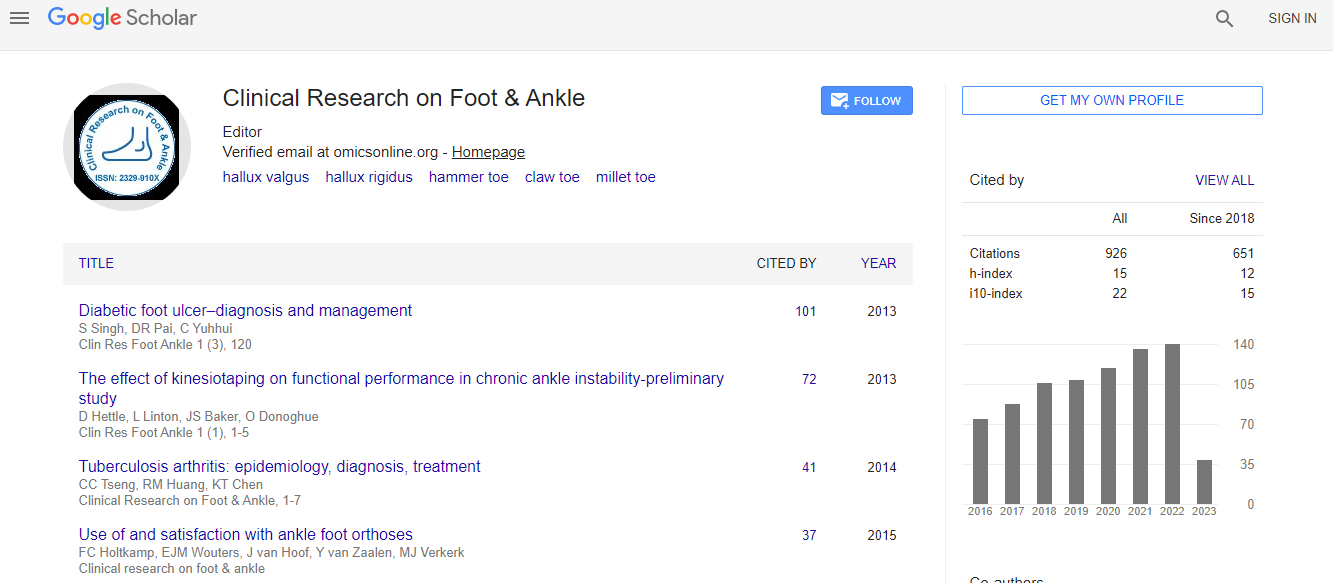Research Article
Long-Term Economical Effects of Isolated Calcaneus Fracture Depending onInsurance Status, Age, Occupation and Fracture Type
Soren Peters1, Jan Persson1, Padhraig O´Loughlin2, Christian Krettek1 and Ralph Gaulke1*1Department of Traumatology, Hannover Medical School, Carl-Neuberg-Str.1, 30625 Hannover, Germany
2Department of Orthopedic Surgery, Hospital of Special Surgery, New York, USA
- *Corresponding Author:
- Ralph Gaulke
Section Upper Extremity
Foot and Rheumatology Surgery
Department of Traumatology
Hannover Medical School
Carl- Neuberg-Str.1
30625 Hannover, Germany
Tel: 0049-511 532 2026
E-mail: gaulke.ralph@mh-hannover.de
Received date: December 12, 2016; Accepted date: January 09, 2017; Published date: January 16, 2017
Citation: Peters S, Persson J, Loughlin PO, Krettek C, Gaulke R (2017) Long-Term Economical Effects of Isolated Calcaneus Fracture Depending on Insurance Status, Age, Occupation and Fracture Type. Clin Res Foot Ankle 5:225. doi: 10.4172/2329-910X.1000225
Copyright: © 2017 Peters S, et al. This is an open-access article distributed under the terms of the Creative Commons Attribution License, which permits unrestricted use, distribution, and reproduction in any medium, provided the original author and source are credited.
Abstract
Background: The influence of insurance status on clinical outcome and function, such as the duration of time that the patient is unable to work has not yet been fully elucidated upon in the literature, as it pertains to calcaneal fractures. These injuries are typically associated with a significant economic burden for both patient and society. In a retrospective clinical and radiological case-control study of 44 patients, with an isolated calcaneus fracture, the influence of the insurance status was evaluated.
Methods: The average follow-up time period was ten years (range 4.2 to 15.0 years). Patient satisfaction was assessed using the SF-36, AOFAS-Score, ACFAS-Score, Hannover-Score and Foot Function Index. Data relating to inability to work, reduction in ability to work/degree of disability and were collected using a standardized questionnaire. Radiologic follow-up was involved evaluation of the degree of arthrosis in the subtalar joint.
Results: The scoring systems employed revealed significant differences between the work liability and public statutory insured patients in the physical component (PCS) with SF-36 (p=0.003), AOFAS (p=0.002), ACFAS (p=0.002), Hannover-Score (p=0.003), FFI (p=0.001). Additionally, the work incapacity duration (p=0.006) and the frequency of detection of a reduction in ability to work and degree of disability (p=1.8 × 10-8) was significantly different between the two cohorts, and independent of age, occupational group and fracture type.
Conclusion: Thus, it may be deduced that insurance status, does indeed exert a significant influence on clinical outcome and specifically, the magnitude of the duration of time when a patient is deemed unable to work.

 Spanish
Spanish  Chinese
Chinese  Russian
Russian  German
German  French
French  Japanese
Japanese  Portuguese
Portuguese  Hindi
Hindi 
